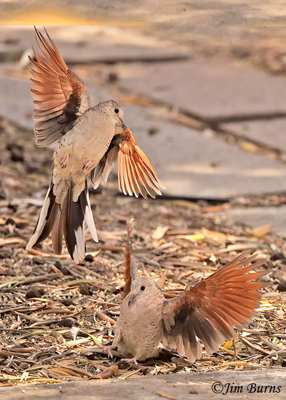
To us the most fascinating thing about yard birding is not the waiting for an occasional vagrant to show up (Rufous-backed Robin and Gray Catbird) have been the “best” of those for us in twenty years), but the daily parade/scrum of the common birds that visit. Most of those end up on the ground picking over the fallen olives, thistle, and sunflower seeds, and the interesting thing we’ve noticed is that size seems to be the most important, but not the only, determinant of the pecking order.
I’m not even mentioning the White-winged Doves (11 1/2 inches) which are not around our yard when we feed, though they do overwinter now in some areas of the state. We would discontinue feeding if they were here in winter as they are truly “seed hogs” and the biggest bullies in our yard at other times of the year.
We always seem to have a pair or two of Eurasian Collared-Doves (12 1/2 inches) around, often including an almost white individual which back in the day was known as Ringed Turtle-Dove, now Streptopelia capicola. These species of invasive doves have interbred to the extent we don’t try to keep up with the taxonomy, but oddly enough they defer to both our Gambel’s Quail (11 inches) and our Mourning Doves (12 inches). The Gambel’s dominance, of course, seems somewhat logical because the quail are plump, probably weight more than any dove, and routinely get rowdy with one another. No one else in the yard messes with them.
The biggest surprise has been that the collared-doves immediately abandon a food item when the noticeably smaller Mourning Doves approach. The latters’ method of dominance over any species that dares resist is to peck them unmercifully, giving true meaning to the term “pecking order.” In fact, it is the Mourning Doves that have earned “yard bully” status, their usual victims being their own kind and the much smaller Inca Doves (8 1/4 inches). Mourning Doves just seem to be wired differently, and many of their Inca victims sport tufts of disheveled feathers throughout the day.
Then the Incas, in turn, take out their frustrations on their own kind and the smaller White-crowned Sparrows (7 inches) and House Finches (6 inches). The latter two, along with the single White-throated Sparrow (6 3/4 inches) visiting this winter, never feel the wrath of the Incas’ bill as they move out of the way whenever an Inca even approaches.
Interestingly enough, though, the lone White-throated takes a run at every marginally larger White-crowned that approaches it, and the latter always defer and scamper away. We think the reason is either the former is more robust and slightly heavier than the lengthier White-crowneds or perhaps it presents a more intimidating visual by virtue of its wider white stripes and larger, more contrasting white throat patch.
We have one Yellow-rumped Warbler (5 1/2 inches) around this year sharing the olives, but it looks tiny next to everything else, and it takes wing at any and every disturbance in the yard. The Orange-crowned Warblers (5 inches) that we usually see every year are conspicuous by their absence this winter, but they have also enjoyed the olives in winters past.
These nearly constant interactions and skirmishes are a source of amusement and amazement, and would potentially provide research fodder for a serious ornithology graduate student. For yard birders unable to travel or those trying to limit their carbon footprint, the monthly seed bill is lower than the price of fuel, and for us the action in our yard is justification for not ripping out our old olive trees.